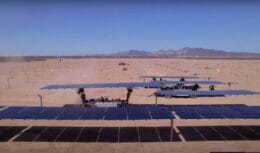
The obvious solution to rising costs is to charge customers more, but this will impact and increase the cost of electricity.
Giant global wind turbine makers Vestas Wind Systems and Siemens Gamesa Renewable Energy seem to be better at making wind turbines than making money, despite high demand for their products. Shrinking operating margins mean both companies, which have €80bn of orders, have no choice but to charge customers more. This marks the end of the long-term downward trend in wind energy prices.
Read also
- Three giant wind turbine blades, measuring 61 meters and weighing 126 tons, fell from the ship while carrying out scheduled maintenance
- With the price of a cell phone, it is possible to have your mini wind turbine for R$ 2.500, and produce energy at home with the same operation as that of large wind farms
- The largest wind turbine in the world will be Chinese: wind turbines that China plans to use in the construction of its most ambitious wind farm are more powerful than General Electric's Haliade-X
- The largest and most powerful wind turbine on the planet, the Haliade-X, manufactured by General Electric, breaks the world production record reaching 14 MW, being just a prototype!
Vestas and Siemens Gamesa are among the handful of companies that dominate the global wind turbine market
The Danish company and its Spanish-German rival are among the handful of companies that dominate the global wind turbine market. The others are American General Electric and Chinese duo Envision Energy and Xinjiang Goldwind Science & Technology. It's a nice place, given the wind's vital role in reducing dependence on fossil fuels.
To limit global warming to 1,5 degrees Celsius, the International Energy Agency estimates that annual new wind capacity will have to rise from 114 gigawatts last year to 350 gigawatts in 2050, when renewables supply nearly 90% of the world's energy. .
Generous support from governments made the sector competitive in its early years. Technological improvements and economies of scale – the latest wind turbines are almost as tall as the Torre Eiffel – made these aids obsolete. Lazard estimates that the total cost of wind power has dropped 72% over the last 12 years, to an average of $38 per megawatt hour. That's about three-quarters of the cost of gas power in the United States.
Price drop impacts turbine makers' revenue
The drastic price drop has been great news for the climate and taxpayers. It hasn't been so much for turbine makers, who are facing reduced subsidies as maturing technologies reduce their own ability to deliver bigger and better turbines for less money.
Vestas' operating margin has fallen from 14% to 5% over the past five years, against its long-term target of 10%. Add the rising cost of everything from steel or fiberglass resin to shipping, wind turbine manufacturers are about to sail into the wind. Siemens Gamesa, for example, is likely to generate operating losses this year.
The obvious solution is to charge customers more. The sector has high barriers to entry for new players: manufacturing a 90-meter turbine blade is difficult. Therefore, the market weight of traditional operators should allow them to pass on the increased costs. But these price increases are negligible for the cost of electricity. The trend towards increasingly cheaper wind power may have run its course.
With the price of a cell phone, it is possible to have your mini wind turbine for R$ 2.500, and produce energy at home with the same operation as that of large wind farms
The average energy consumption in a Brazilian residence is R$ 487,22 per month. A mini wind turbine project promises to reduce this bill to up to R$ 163,06! The constant increases in the electricity bill have taken the sleep of families, who no longer know what to do to save. On the other hand, affordable and low-cost technological solutions available on the internet have allowed the installation of mini wind turbines in homes, which provides good savings in projects that pay for themselves in a short time, see below how to acquire yours! Watch the video below and see how to install your mini wind turbine.












